Mobile App Investigations
- Static Versus Dynamic Analysis
- Dating Apps
- Rideshare Apps
- Communication Apps
- Summary
- Key Terms
- Assessment
In this sample chapter from A Practical Guide to Digital Forensics Investigations, 2nd Edition, you will explore the importance of mobile apps in investigations, learn how to perform a static and dynamic analysis, analyze SQLite databases, and more.
Chapter 10. Mobile App Investigations
Learning Outcomes
After reading this chapter, you will be able to understand the following:
The importance of mobile apps in investigations;
How to perform a static and dynamic analysis;
The digital evidence available from dating, rideshare, and other popular apps;
The value of deep-linking in investigations; and
Analyzing SQLite databases.
Mobile applications (apps) are extremely important today in investigations for a variety of reasons. Interestingly, the databases associated with many apps, are unencrypted and are not too difficult to analyze. Furthermore, if a mobile device is locked or inaccessible, there are many other options available, which may include analyzing a linked desktop version of the app or sending a subpoena, or court order, to a third-party provider to obtain a suspect’s data. Third-party companies collect, and store, a tremendous amount of data on their customers. Finally, many users opt to back up their data to cloud storage. For example, WhatsApp has the option for Apple iPhone/iPad users to back up their chats to iCloud, and that backup can be requested from Apple. Nevertheless, organized criminals and terrorist groups largely use mobile apps that utilize strong encryption or proprietary encryption, which can seriously hamper the work of law enforcement. Compounding these concerns is the fact that many apps maintain their servers in countries like Russia, which is beyond the reach of law enforcement in the West. Popular communication apps that use strong encryption include Telegram, Signal, Wickr, and Threema to name but a few. Nevertheless, zero-day exploits are frequently found in mobile apps, including Telegram, which can help investigators to gain access to an encrypted app. A zero-day exploit is a security vulnerability that is a threat on the day that it is discovered because a software patch, to fix the exploit, does not yet exist.
Static Versus Dynamic Analysis
During app installation, typically a SQLite database will be installed on the user device. This is a relational database that is comprised of tables. The data stored in these tables may or may not be encrypted. A table may contain a user’s contacts, while a related table may store communications with contacts, for example. It is important to understand that these databases contain an extraordinary amount of personal information and, when unencrypted, can put an individual at risk for social engineering. Additionally, we should always consider the possibility to subpoena a third-party service provider for evidence.
When analyzing mobile apps, there are several approaches that an investigator can take, in order to examine the user data. A static analysis includes an examination of the SQLite database associated with that app. A dynamic analysis of the app is an analysis of the behavior of the application once it has been executed (or run). The sections that follow examine static analysis and dynamic analysis in more detail.
Static Analysis
A SQLite database is a relational database that is the preferred storage for data associated with mobile apps. SQLite is a C-language library that is responsible for the SQL database. SQLite source code is source code that resides in the public domain. Forensic tools, like BlackLight, enable the user to easily browse through application SQLite databases but there are other standalone tools that can be used. One of these tools is SQLite Database Browser, which is freeware. Later in this chapter we shall detail the types of evidence available from a number of popular mobile apps. Figure 10.1 shows an example of a SQLite database for the Tinder app on an iPhone.

FIGURE 10.1 Tinder SQLite database on iOS (iPhone)
A cursory view of the information in Figure 10.1 shows that there are many folders and files associated with a mobile app SQLite database. Ultimately, the database could have five tables or could have 100 tables, which means that a thorough examination can be a painstaking process. Within each SQLite database (.sqlite) you will find databases, which will contain the file extension .db; for example, google_analytics.db. You will often find recognizable files, like .jpg (picture images), .vcf (or vCard for your contacts), or .mp3 (sound file).
The chart in Figure 10.2 provides a general outline of how an iOS application is stored on an iPhone or iPad.

FIGURE 10.2 Application storage on iOS
The Library folder, which is highlighted in Figure 10.2, is where you will find the all-important user data, including cache, cookies, and other personal information. In the Preferences folder, which is displayed and highlighted in Figure 10.3, you may actually discover usernames and passwords that are stored in plaintext.
In Figure 10.4, we can view the name com.cardify.tinder and this is referred to as a bundle ID. A bundle ID is a uniform type identifier, which is comprised of alphanumeric characters, that uniquely identifies a specific app. The bundle ID for Microsoft’s iOS Outlook app is com.microsoft.Office.Outlook. Thus, the format for the bundle ID is generally com.<YourCompany>.<AppName>, which is referred to as a reverse-domain name style string. When you visit the Apple App Store and search for the Microsoft Outlook app for iOS, then you will arrive at this URL in your web browser: https://apps.apple.com/us/app/microsoft-outlook/id951937596. Notice the “id951937596”, which identifies this app on the App Store. An iOS app also has a unique identifier known as an App ID. An App ID is a two-part string that identifies a development team (Team ID) and an application (bundle ID). The Team ID is created and assigned by Apple, while the bundle ID is generated by the app developer.

FIGURE 10.3 Tinder SQLite database on iOS

FIGURE 10.4 Tinder SQLite database on iOS
Static Analysis: Code Review
Another form of static analysis refers to performing a code review on a mobile app, which can help the investigator understand the type of evidence that is available. In terms of the evidence available for an Android app (.apk or Android Package) there is the manifest, which shows the permissions associated with a particular app. For example, the manifest may show that the app is collecting user location information (“COARSE_LOCATION” and/or “FINE_LOCATION”). ACCESS_COARSE_LOCATION is a permission that enables the app to access the approximate location of the user device, which is based on NETWORK_PROVIDER (cell sites, i.e. cell towers). ACCESS_FINE_LOCATION enables the app to determine the location of the user device based on NETWORK_PROVIDER and GPS (GPS_PROVIDER). An Android application contains a file at the root of the project source set, which is called AndroidManifest.xml. An Android manifest file contains the application’s package name, its functionality, permissions, hardware, and software requirements for installation.
Understanding the permissions associated with an app allows the investigator to understand the type of evidence that can be requested from the provider and the type of evidence to look for when examining the SQLite database. The latter is important because examining one database can take many days, or even weeks, and therefore limiting the scope of your analysis is key. Example 10.1 shows a small extract from an Android manifest for WhatsApp.
Example 10.1 Android Permissions Manifest for WhatsApp
<manifest xmlns:"http://schemas.android.com/apk/res/android"
android:versionCode="451048" android:versionName="2.12.550" package="com.whatsapp"
platformBuildVersionCode="23" platformBuildVersionName="6.0-2166767">
<uses-sdk android:minSdkVersion="7" android:targetSdkVersion="23" />
<uses-permission android:name="android.permission.ACCESS_COARSE_LOCATION" />
<uses-permission android:name="android.permission.ACCESS_FINE_LOCATION" />
<uses-permission android:name="android.permission.ACCESS_NETWORK_STATE" />
<uses-permission android:name="android.permission.ACCESS_WIFI_STATE" />
<uses-permission android:name="android.permission.AUTHENTICATE_ACCOUNTS" />
<uses-permission android:name="android.permission.BLUETOOTH" />
<uses-permission android:name="android.permission.BROADCAST_STICKY" />
<uses-permission android:name="android.permission.CAMERA" />
<uses-permission android:name="android.permission.CHANGE_WIFI_STATE" />
<uses-permission android:name="android.permission.GET_ACCOUNTS" />
<uses-permission android:name="android.permission.GET_TASKS" />
<uses-permission android:name="android.permission.INSTALL_SHORTCUT" />
<uses-permission android:name="android.permission.INTERNET" />
<uses-permission android:name="android.permission.MANAGE_ACCOUNTS" />
<uses-permission android:name="android.permission.MODIFY_AUDIO_SETTINGS" />
<uses-permission android:name="android.permission.READ_CONTACTS" />
<uses-permission android:name="android.permission.READ_PHONE_STATE" />
An understanding of the manifest is also important from a mobile security perspective. Many privacy policy statements are misleading or confusing and provide poor guidance about how trustworthy a mobile app is. The Federal Trade Commission (FTC), for example, investigated a popular free app for Android, called the Brightest Flashlight, after it was discovered that the app requested many more permissions from the user’s device beyond the light function on the device. Therefore, some app permissions are high risk, while other permissions are low risk.
A Web search for the “Uber APK file”, or any other APK file, quickly identifies where the application package can be downloaded. Once the APK has been downloaded, there are a number of applications that can be used to review the code and manifest for the APK. One tool for reviewing the APK developer code is dex2jar (dex compiler), which can be downloaded from SourceForge. Another application for viewing the APK is FileViewer Plus. One preferred tool is an online Java APK decompiler application, which is available from www.javadecompilers.com/apk. With this tool, you can decompile your APK in a web browser without downloading an APK decompiler to your computer. Therefore, you do not need to worry whether the application that you are downloading is from a trusted source because the application is being run from their web server and not from your computer. There are numerous other source code analytical tools that an investigator can use, including SourceMeter, JSLint, and FindBugs. Figure 10.5 shows the JSLint user interface.

FIGURE 10.5 JSLint user interface
Dynamic Analysis
A dynamic analysis of the app is an analysis of the behavior of the application once it has been executed (or run). An Android emulator is an application that simulates, or runs, the Android operating system in a virtual machine. These applications are generally developed for use with a personal computer and run as a virtual machine. App developers use an emulator to analyze how their apps will run before making them available to the public. However, an emulator can also benefit investigators who are interested in viewing the behavior of an app—especially if an app potentially contains malware. This is the benefit of using an emulator that operates as a virtual machine. An investigator may also be interested in monitoring the permissions and DNS connections associated with an executed mobile app. In terms of monitoring DNS connections (connections to servers), there is Wireshark (Windows) and Debookee (macOS), which are very effective at monitoring these connections over a wireless network. Figure 10.6 shows a screenshot of a pcap (packet capture) file from Wireshark. A pcap file is a wireless packet that contains user data and network data related to the sender and receiver of that data.

FIGURE 10.6 Google Maps API identified in a PCAP captured by Wireshark
To remain safe and compliant, consider using a personal hotspot device, like a Verizon Jetpack, in a secure lab. A tool like Debookee also has the ability to encrypt some wireless traffic, which means that while app data may be encrypted on the device and on the server, often companies will implement poor encryption protocols, whereby the data in transmission can be intercepted and viewed in plaintext. Thus, tools like Debookee can also be used, by security professionals analyzing apps, to try to determine how secure apps are.
Introduction to Debookee
Debookee is a comprehensive wireless packet sniffer for macOS. The tool is not passive as it performs a man-in-the-middle (MITM) attack to intercept data from mobile and IoT devices. A man-in-the-middle (MITM) attack is an attempt to intercept electronic communications between two computing devices, with the intent to decipher encrypted messages. The tool also performs SSL/TLS decryption. Debookee supports numerous protocols, including HTTP, HTTPS, DNS, TCP, DHCP, SIP, and RTP (VoIP). The tool can be used to identify what data is being collected and shared by mobile apps. In other words, you can identify DNS connections to servers around the world and other companies that could be potentially subpoenaed for information. The data generated from one mobile app can be shared with fifty or more third-party companies, which are mostly analytics companies like Crashlytics, UXCam, Fabric, etc.
On the homepage of the Debookee website, click the Download button and install the software.
Once you install the software and start the program, you will see an interface, similar to Figure 10.8. The IP address, MAC address, and host name that are displayed provide information about your device.
Figure 10.9 shows a close-up of the information that we just discussed. Click the Start LanScan button as highlighted in Figure 10.9.

FIGURE 10.7 Debookee home page

FIGURE 10.8 Debookee user interface
You will then see a list of all devices that are connected to the same wireless access point as your computer. Once you select your target device, click the Pcap option, on the upper left of your screen, and then click Save Pcap files, as shown in Figure 10.10.

FIGURE 10.9 Debookee user interface with host computer information displayed

FIGURE 10.10 Save Pcap files option in Debookee
You can then click the Open Export Folder button to change the default export folder. There is an add-on tool in Debookee, which allows you to decrypt the contents of the pcap files. If you purchase this option, you can click the SSL/TLS button displayed in Figure 10.11.
The next step in the TLS decryption process is to install the certificate authority (CA) on the machine (see Figure 10-12). To start your NA, click the Play button ▸ in the very top left of your application screen (underneath it says, “Start NA”). Once the trust certificate has been installed, you should stop the NA (Network Analysis) by clicking the same button.

FIGURE 10.11 SSL/TLS decryption option in Debookee
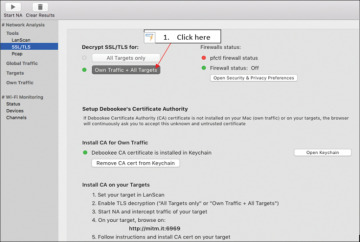
FIGURE 10.12 Decryption option in Debookee
From the screen in Figure 10.13, click the Start NA ▸ button again. Open the webpage, or application, you want to analyze (or the device that you wish to monitor), and begin generating data packets by opening and closing different functions, sending messages, or just using the application.

FIGURE 10.13 Start NA option in Debookee
On the left column in Figure 10.14, under Own Traffic, you will see that DNS and HTTP have populated. The NA will run continuously until you terminate it. When you are satisfied with the data collected, press the stop button. Remember that your pcap files are automatically exported to the folder that you previously selected.
Click DNS in the left column and you will see all DNS connections made during the NA (timestamped) with the hostname and/or IP address. These are the IP addresses and hosts that you can analyze, in addition to the pcaps.
It is recommended that you click File > Export and save this list as a .doc or a .txt file. You can then use some open source DNS analysis tools, including www.robtex.com and www.dnsdumpster.com.
Clicking the HTTP button, as shown in Figure 10.15, will display an itemized list of every packet transmitted over HTTP, HTTPS, TCP, SIP, IMAP, and other protocols. If you did not purchase the SSL/TLS decrypt module, HTTPS packets (transmitted over port 443 using TLSv1.2) will display in red, and you will not be able to read the data until you decrypt the packets. Port 443 is the port number for secure HTTP communications—in other words, Web traffic. If you did purchase the SSL/TLS decrypt module, HTTPS packets will display in black, and when you click on them, the data will be displayed in plaintext in the data field.
Click on a packet that you wish to examine. In the data field you will see some text populate underneath the tab labeled Request. Upon further inspection of the data field, you will see the full GET request along with the packet parameters and data, as displayed in Figure 10.16. GET is an HTTP method used to request data from a specific resource, like a web server.
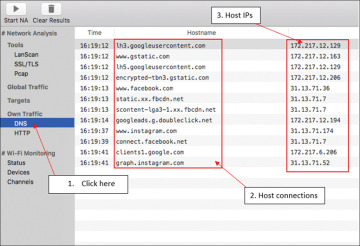
FIGURE 10.14 DNS connections captured
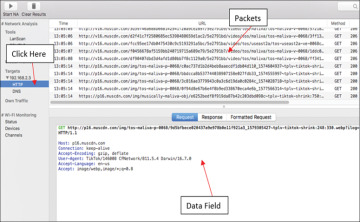
FIGURE 10.15 Decrypted TikTok packet (pcap)
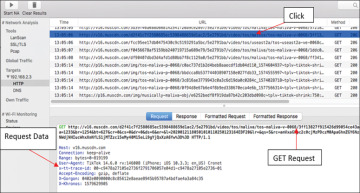
FIGURE 10.16 GET request data displayed
You may then click the Response tab to view the webpage or application response packet. Figure 10.17 displays a webpage response. Status code 200 means that it was successfully downloaded.
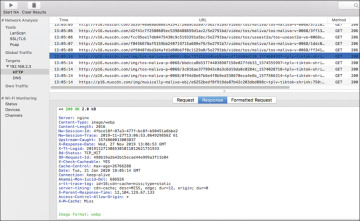
FIGURE 10.17 Response results
You can choose to export your packets so that they can be analyzed later. You can select to view your packet data in a text file or in a Word document. Figure 10.18 displays the option to export the packet data.
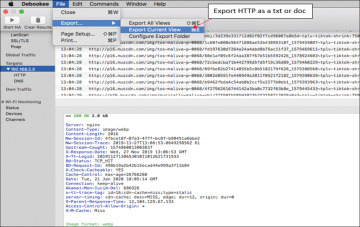
FIGURE 10.18 Data Export feature in Debookee
In Figure 10.19 and Figure 10.20 you can view the location and message data that was transmitted in plaintext while using the popular dating application Tinder. This data was observed while inspecting the entire packet in a text document.
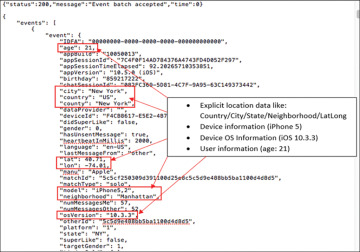
FIGURE 10.19 Location, device, and user information from the Tinder app
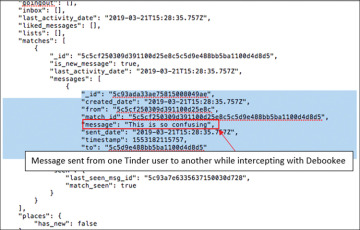
FIGURE 10.20 Message from the Tinder App Displayed in Plaintext
The pcaps generated by Debookee can then be exported and analyzed using the Wireshark application. Wireshark can also perform data capture and is recommended for Windows users.
